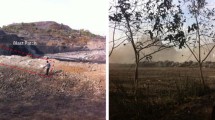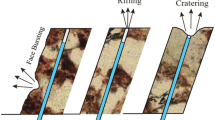Abstract
Back break is an unsolicited phenomenon caused due to rock condition, blast geometry, explosive and initiation system in mines. It does not help in creating a smooth high wall and free face for next blasting due to cracks, overhang and under-hang. It can cause rockfall during drilling due to the cracks present in the in situ rock mass at the perimeter. Due to improper free face created from the previous blast and the presence of loose strata in the face increases the overall cost of production. Therefore, predicting and subsequently optimising back break shall reduce their problems to some extent. In this paper, an attempt is made to predict back break using the random forest method. The variables used for the study was such as burden to spacing ratio, stemming to hole-depth ratio, p-wave velocity and the density of explosive. For the random forest model, R2 0.9791 and RMSE 0.87899 and for linear regression was R2 was 0.824 and root mean square error (RMSE) 0.72, respectively. From the field trials, it was evident that the use of low-density emulsion can help in reducing the back break and optimise the overall cost of the blasting process. The same results were validated using Random forest method wherein the model R2 was 0.9791 and RMSE was 0.8799.



Similar content being viewed by others
References
CL Jimeno EL Jimeno FJA Carcedo YV Ramiro De 1995 Drilling and blasting of rocks, geomining technological institute of Spain Rotterdam Netherlands AA Balkema
Konya CJ (2003) Blast design in rock blasting and overbreak control
Gates WCB, Ortiz LT, Florez RM (2005) Analysis of rockfall and blasting backbreak problems, US 550, Molas Pass, CO. Alaska Rocks 2005, 40th US Symp. Rock Mech., American Rock Mechanics Association
M Monjezi H Dehghani 2008 Evaluation of effect of blasting pattern parameters on back break using neural networks Int J Rock Mech Min Sci 45 1446 1453
Tian E, Zhang J, Tehrani MS, Surendar A, Ibatova AZ (2018) Development of GA-based models for simulating the ground vibration in mine blasting. Eng Comput pp 1–7
A Saghatforoush M Monjezi RS Faradonbeh DJ Armaghani 2016 Combination of neural network and ant colony optimization algorithms for prediction and optimization of flyrock and back-break induced by blasting Eng Comput 32 255 266
M Monjezi M Ahmadi M Sheikhan A Bahrami AR Salimi 2010 Predicting blast-induced ground vibration using various types of neural networks Soil Dyn Earthq Eng 30 1233 1236 https://doi.org/10.1016/j.soildyn.2010.05.005
H Sheykhi R Bagherpour E Ghasemi H Kalhori 2018 Forecasting ground vibration due to rock blasting: a hybrid intelligent approach using support vector regression and fuzzy C-means clustering Eng Comput 34 357 365
TK Ho Random decision forests. Doc. Anal. recognition, 1995 Proc. third Int. Conf., vol. 1 IEEE 1995 278 282s
TG Dietterich 1998 An experimental comparison of three methods for constructing ensembles of decision trees: Bagging, boosting and randomization Mach Learn 32 1 22
L Breiman 2001 Random forests Mach Learn 45 5 32
Li H, Feng D, Ma H (2015) Random forest prediction model and its application to predicting house hazard from cutting excavation blasting. J Liaoning Tech Univ Nat Sci 12:16
D Longjun L Xibing X Ming L Qiyue 2011 Comparisons of random forest and support vector machine for predicting blasting vibration characteristic parameters Procedia Eng 26 1772 1781
CJ Chen CH Liu YJ Chen YJ Shen 2016 Evaluation of machine learning methods for ground vibration prediction model induced by high-speed railway J Vib Eng Technol 4 283 290
M Monjezi M Rezaei A Yazdian 2010 Prediction of backbreak in open-pit blasting using fuzzy set theory Expert Syst Appl 37 2637 2643 https://doi.org/10.1016/j.eswa.2009.08.014
Persson P-A, Holmberg R, Lee J (1993) Rock blasting and explosives engineering. CRC Press, New Yor
Paventi M, Lizotte Y, Scoble M, Mohanty B (1996) Measuring rock mass damage in drifting. Mohanty (Ed), Rock Fragm by Blasting 131–8
TR Yu S Vongpaisal 1996 New blast damage criteria for underground blasting CIM Bull 89 139 145
Eloranta J (2003) Characterization of the pre and post blast environments. Proc. Annu. Conf. Explos. BLASTING Tech., vol. 2, ISEE; 1999; 2003, p 263–72
Gengshe Y, Dingyi X, Changqing Z, Yibin P (1999) CT analysis on mechanic characteristics of damage propagation of rock. Chin J Rock Mech Eng
JA Sanchidrian P Segarra LM Lopez 2007 Energy components in rock blasting Int J Rock Mech Min Sci 44 130 147
GF Brent GE Smith GN Lye 2002 Studies on the effect of burden on blast damage and the implementation of new blasting practices to improve productivity at KCGMs Fimiston Mine Fragblast 6 189 206
T Sasaoka H Shimada T Sasaki M Ichinose K Matsui 2008 Study on control of rock fragmentation at limestone quarry J Coal Sci Eng 14 365 368
Singh SP (1993) Prediction and determination of explosive induced damage. fourth Int. Symp. rock Fragm. by blasting, p 5–8
PH Oliver 2003 Changes to drill pattern and adequate inter-row delay time improve blasting performance CIM Bull 96 60 65
DA Bartley R McClure R Trousselle 2003 Electronic detonator technology in open pit mining CRC Press Explos. Blasting Tech. 180 187
AM Youssef HR Pourghasemi ZS Pourtaghi MM Al-Katheeri 2016 Landslide susceptibility mapping using random forest, boosted regression tree, classification and regression tree, and general linear models and comparison of their performance at Wadi Tayyah Basin, Asir Region Saudi Arabia Lands 13 839 856
V Rodriguez-Galiano M Sanchez-Castillo M Chica-Olmo M Chica-Rivas 2015 Machine learning predictive models for mineral prospectivity: An evaluation of neural networks, random forest, regression trees and support vector machines Ore Geol Rev 71 804 818
Freedman DA. Statistical models: theory and practice. cambridge university press; 2009.
VK Himanshu MP Roy AK Mishra RK Paswan D Panda PK Singh 2018 Multivariate statistical analysis approach for prediction of blast-induced ground vibration Arab J Geosci 11 460
Funding
All the funding sources have been acknowledged.
Author information
Authors and Affiliations
Corresponding author
Ethics declarations
Conflict of interest
Authors have no conflict of interest.
Permissions
Permissions have been taken from the competent authority of the mines for sample collection and conduction of the study.
Additional information
Publisher's Note
Springer Nature remains neutral with regard to jurisdictional claims in published maps and institutional affiliations.
Rights and permissions
About this article
Cite this article
Kumar, S., Mishra, A.K. & Choudhary, B.S. Prediction of back break in blasting using random decision trees . Engineering with Computers 38 (Suppl 2), 1185–1191 (2022). https://doi.org/10.1007/s00366-020-01280-9
Received:
Accepted:
Published:
Issue Date:
DOI: https://doi.org/10.1007/s00366-020-01280-9




